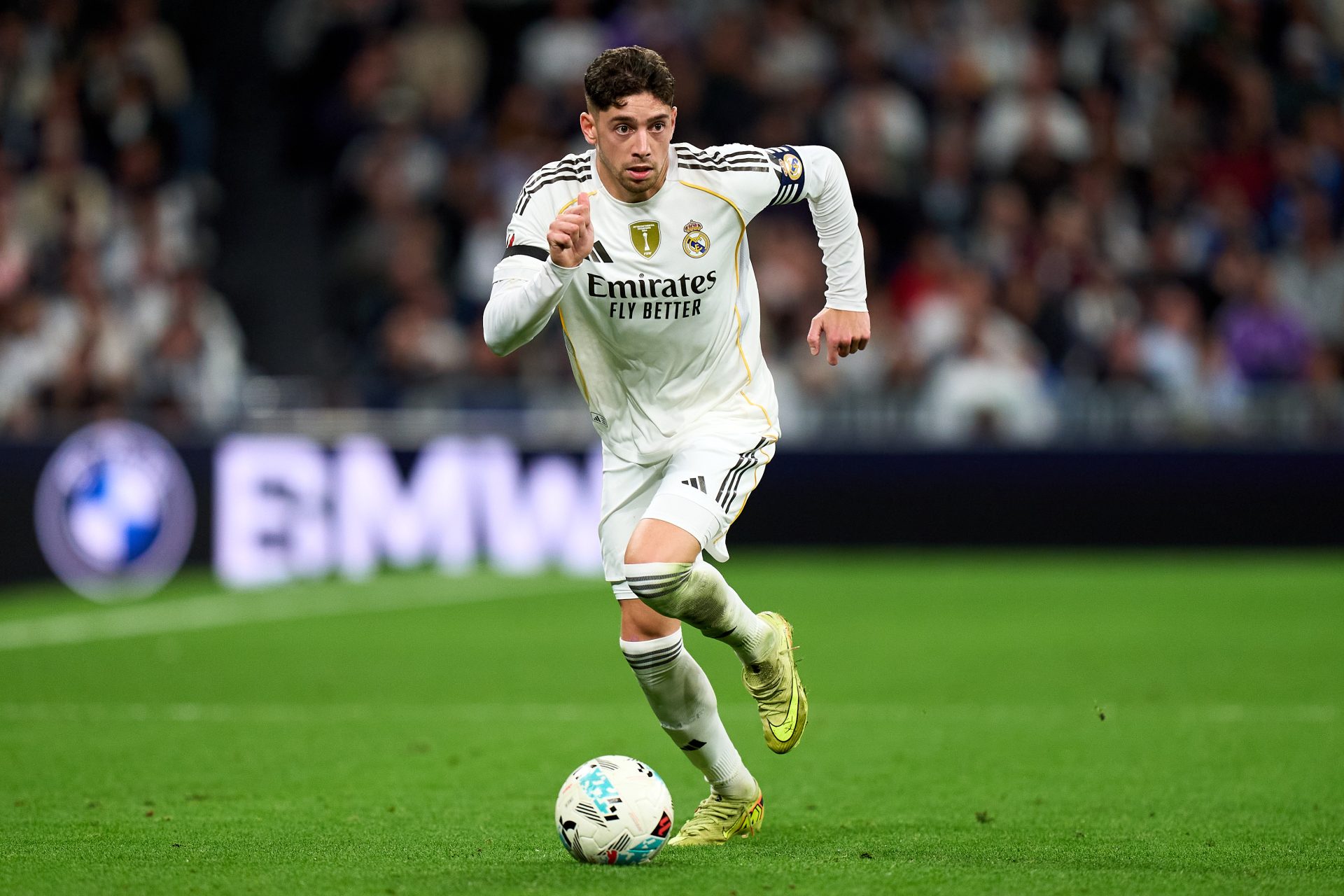Valverde’s Injury: A Clear Signal of Real Madrid’s Fragility in the Face of Adversity, Much Like David’s Struggle Against Goliath in a Modern Football Battlefield
Real Madrid’s recent encounter with Liverpool at Anfield, which ended in a narrow 0-1 defeat, has raised significant concerns for the club—not only due to the disappointing result but also due to the injury sustained by one of their key players, Federico Valverde. This situation highlights a deeper issue within the squad’s current state, reflecting the precarious balance between strength and vulnerability that is often seen in high-stakes competitive environments.
Federico Valverde has emerged as an influential figure in Madrid’s midfield, contributing not only defensively but also in transitioning from defense to attack. His work rate and tactical awareness have made him indispensable under manager Xabi Alonso. However, the setback following the match against Liverpool, where Valverde finished with a muscle injury, could significantly impact the team’s performance in upcoming fixtures. Reports indicated that the Uruguayan international suffered an adductor muscle strain, leading to his substitution in the dying moments of the game while appearing to clutch his leg in evident discomfort.
In the wake of the match, Valverde expressed uncertainty regarding the extent of his injury, mentioning that initial assessments suggested fatigue rather than serious damage. Nevertheless, the necessity for diagnostic tests looms large, and the next 24 hours are critical for determining his availability. Should the injury prove more severe than initially thought, Real Madrid could face a significant tactical disruption, particularly with the November international break on the horizon.
Xabi Alonso’s tactical strategies have often relied on the stability Valverde provides on the right side of midfield. He has been crucial in defensive scenarios, helping to cover for full-backs and ensuring that the team’s shape remains intact during transitions. This was particularly evident against Liverpool, where Alonso strategically positioned Valverde to combat the pressing and attacking threats posed by the English side.
However, the situation becomes more dire when considering Real Madrid’s growing injury list. With established defenders like Dani Carvajal, Antonio Rudiger, and David Alaba already sidelined, Alonso faces the daunting task of reshaping his lineup. The absence of Valverde could leave gaps in both midfield and defensive structures, forcing the manager to rethink his approach and possibly rely more heavily on younger or less experienced players, such as those currently nursing injuries or recovering from fatigue.
Moreover, the potential repercussions extend beyond tactical adjustments. Real Madrid has historically thrived on its depth and versatility within the squad, but repeated injuries to key players could expose cracks in this foundation. The expectations for success at a club of Real Madrid’s stature are immense, and any slip in form can lead to significant pressure not just on the coaching staff but also on the players to perform under duress.
Injuries in professional football are not merely physical setbacks; they can also weigh heavily on team morale. A shared sense of vulnerability within a squad can impact performance levels, fostering an atmosphere of uncertainty and apprehension. If Valverde were to miss time due to a more serious condition, it could undermine the team’s confidence heading into critical matches, ultimately affecting their pursuit of silverware this season.
Furthermore, the psychological aspects of dealing with injuries can’t be overlooked. Players like Valverde, who are pivotal for a team’s success, often feel the additional pressure to return quickly. The fear of letting down teammates, management, and fans can lead to hasty comebacks, which, if premature, can exacerbate injuries and prolong recovery periods.
As Real Madrid looks ahead, the club must navigate this period of uncertainty with strategic foresight. An over-reliance on a handful of key players can create an unsustainable cycle of dependency, which ultimately can be detrimental. While the emergence of young talent is promising, the integration of inexperienced players into a high-pressure environment requires careful management and a prudent approach to squad rotation.
In terms of their historical context, Real Madrid has witnessed many highs and lows due to injuries. Legendary players have struggled with the demands of the sport, and the club has adapted time and again. The resilience shown in the club’s history might serve as a model for the current squad as they combat the adversities of injury woes.
Moreover, with Europe’s elite teams continually improving, Real Madrid cannot afford to be complacent. Their rivals are increasingly adept at exploiting weaknesses, and the absence of key players like Valverde can be the difference between advancing in competitions or facing early exits. Each match becomes a test of depth, strategy, and mental fortitude, and Madrid’s ability to withstand such trials could define their season.
Thus, as the club awaits further evaluations regarding Valverde’s condition, the situation encapsulates the broader themes of fragility and resilience that permeate the world of professional sports. As fans and pundits alike speculate on the implications of this injury, the club will need to rally together, adapt, and face the storm with a collective strength that has been a hallmark of Real Madrid’s storied history.

Real Madrid’s night at Anfield ended in disappointment, not just because of the narrow 0-1 defeat to Liverpool, but also due to fresh injury concerns surrounding one of their most influential midfielders – Federico Valverde.
According to a report from Mundo Deportivo, the Uruguayan international completed the match a muscle injury, prompting concern within the Madrid camp.
Valverde asked to be substituted and was ultimately replaced by Brahim Diaz in the closing moments of the game, clutching his leg in pain after what appeared to be a strain in his adductor muscle.
After the match, Valverde spoke about the situation, admitting uncertainty over the extent of his problem.
“The doctors told me my discomfort comes from fatigue, but we’ll see. I think I will undergo tests tomorrow or the day after,” said the 27-year-old, clearly frustrated by the setback after a physically intense contest at Anfield.
What now?
Real Madrid’s medical staff carried out an initial assessment inside the stadium’s medical room immediately after the final whistle.
![]()
Federico Valverde will be assessed. (Photo by Michael Regan/Getty Images)
Depending on how the pain evolves in the coming hours, the player is expected to undergo an MRI scan to determine whether there is any serious muscle damage.
The next 24 hours will therefore be crucial in deciding Valverde’s availability for the club’s upcoming fixtures.
More trouble for Alonso
Manager Xabi Alonso already finds himself grappling with an alarming injury list, as Dani Carvajal, Antonio Rudiger, and David Alaba remain sidelined, while young talent Franco Mastantuono has also been ruled out due to pubalgia.
The potential absence of Valverde could severely disrupt Real Madrid’s tactical balance, particularly with Carvajal still recovering and Alonso reluctant to rely on Trent Alexander-Arnold in high-stakes encounters.
Against Liverpool, Alonso opted to start Valverde on the right side to maintain defensive stability.
Losing him now, especially with the November international break approaching, would be a major setback.
